Madlener House
4 West Burton Place
Chicago, Illinois 60610
Telephone: 312.787.4071
info@grahamfoundation.org
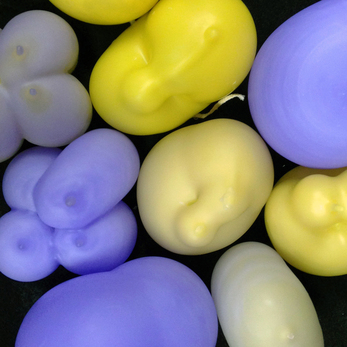
Molly Hunker, inaugural Douglas A. Garofalo Fellow at the School of Architecture at University of Illinois at Chicago, joins the Graham Foundation April 7 for a presentation on her current research and culminating fellowship project, Myth.
Hunker’s fellowship research has centered on kitsch artifacts and their potential to recalibrate contemporary notions of atmosphere and engagement. Myth, opening at UIC School of Architecture April 1, focuses specifically on the home shrine, re-envisioning the richly decorative and kitsch accretion through the lens of the architectural installation. The discussion will explore how home shrines and related assemblies can provoke new understandings of visual opulence and lead to the production of emotionally resonant architecture.
Molly Hunker grew up in Wyoming and earned a Bachelor of Arts degree from Dartmouth College and Master of Architecture degree from the University of California, Los Angeles (UCLA). Hunker has worked for architecture studios and art workshops in Seattle and Los Angeles and has taught at UCLA, Woodbury University and University of Illinois at Chicago. She is the co-founder, with Greg Corso, of SPORTS, a design collaborative that aims to reconcile the intelligence and sensibilities dormant in the crafty, cute and commonplace with that of the high-tech, couture, and complex to distill the opportunities born at this intersection.
Image: Molly Hunker, "Myth" Candles.
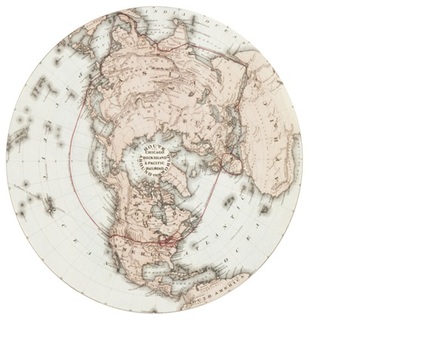
This event brings together the editors and several contributors to the Graham-funded book Chicagoisms: The City as Catalyst for Architectural Speculation, which interrogates Chicago’s history of fomenting and transmitting radical architectural and urban visions. Editor Alexander Eisenschmidt will introduce the project and short presentations by Penelope Dean, Ellen Grimes, Sam Jacob, and Mark Linder, which will be followed by a discussion, moderated by editor Jonathan Mekinda. The event will highlight some of the most productive episodes in the city’s past and explore what made Chicago function so effectively as a mediator of ideas and an instigator of speculation. The book launch also marks the opening of the exhibition “Chicagoisms” at the Art Institute of Chicago. Building on the premise of the book, this exhibition mines the history of the city to define principles of architectural action and urban engagement to which architecture practices were invited to respond via speculative proposals for the contemporary city.
Copies of Chicagoisms: The City as Catalyst for Architectural Speculation will be available for purchase at the Graham Foundation Bookshop.
This event is co-sponsored by the Architecture & Design Society at the Art Institute of Chicago.
Alexander Eisenschmidt is a designer, theorist, and Assistant Professor of Architecture at the University of Illinois at Chicago. His work investigates the productive tension between the modern city and architectural form – a topic on which he has published and lectured extensively. Eisenschmidt is the editor of City Catalyst (AD, 2012), curator of City Works for the 13th International Architecture Biennale in Venice, and founding partner of Studio Offshore.
Jonathan Mekinda is an Assistant Professor at the University of Illinois at Chicago with a joint appointment in the Department of Art History and the School of Design. His research focuses on the history of modern architecture and design during the middle decades of the twentieth century, particularly in Italy, which is the subject of his current book project, Building the House of Man. His writing can be found in journals such as the Journal of Design History and Design Issues and in the forthcoming volume Revival: Memories, Identities, Utopias (Courtauld Books Online, 2015).
Penelope Dean is Associate Professor of Architecture at the University of Illinois at Chicago. Her writings have appeared in Architectural Design, Harvard Design Magazine, hunch, Log, Praxis, and TransScape. Her research has been supported by grants from the Graham Foundation for Advanced Studies in the Fine Arts and a Visiting Scholars Residency at the Canadian Centre for Architecture at Montreal. She is founding editor of the architectural magazine Flat Out.
Ellen D. Grimes is an Associate Professor at the School of the Art Institute of Chicago, where she teaches architectural design, technology, and theory. Previously she has taught at the University of Illinois at Chicago and the Illinois Institute of Technology, and served as the executive editor of the Journal of Architectural Education.
Sam Jacob is an architect and critic. He was co-founder of FAT, where he was responsible for a range of internationally acclaimed projects, and now directs his own architecture and design studio. He is Director of Night School at the Architectural Association in London and teaches at the University of Illinois at Chicago. He is also a columnist for Dezeen and Art Review and contributing editor to Icon. Currently, he is co-curating the British Pavilion at the 2014 Venice Biennale.
Mark Linder is Associate Professor in architecture and Chancellor’s Fellow in the Humanities at Syracuse University. He is the author of Nothing Less than Literal: Architecture after Minimalism (MIT Press, 2004) and is currently at work on a book titled Three Easy Mieses: That’s Brutal, What’s Modern? on the alternative mid-century modernisms of Alison and Peter Smithson, Walter Segal, and John Hejduk.
Image: "Route Via Chicago Rock Island & Pacific Railroad Around the World," 1870. The map celebrates Chicago's status as a metropolis simultaneously distant from and intimately connected to the rest of the world.
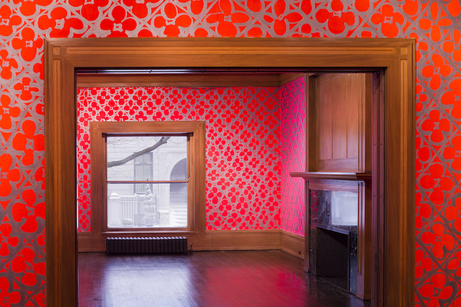
Poet and critic John Yau will discuss the work of Chicago-based painter Judy Ledgerwood in conjunction with the current exhibition Chromatic Patterns for the Graham Foundation.
Interested in the interplay between the visual and linguistic, Yau has explored questions of representation and identity throughout his essays, poetry, and art criticism, attending particularly to the question of the materiality of language and painting. Writing about Judy Ledgerwood’s paintings in 2011, Yau states:
When I was looking at the painting “Spiritualized” (2011), which is brown- violet, magenta, and gold, I was initially reminded of a lavish, oversized box of Godiva chocolates and of church vestments, before other associations began to surface, mostly having to do with the erotic. Such links are as abundant as these paintings are optically and viscerally sumptuous. A carefully considered synthesis of opulence and structure, excess and restraint, is at the heart of Ledgerwood’s work as well as a starting point for speculation.
On April 5, Yau will continue his speculation into Ledgerwood’s work, asking how Ledgerwood’s recent installation for the Graham Foundation asks new questions of the limitations and possibilities of painting as it intersects with and aspires to the conditions of architecture.
John Yau is an American poet, critic, and curator who lives in New York City. He received his B.A. from Bard College and his M.F.A. from Brooklyn College. Yau has published many books of poetry, artists' books, fiction, and art criticism, including Corpse and Mirror (Holt Rinehart, 1983), A Thing Among Things: The Art of Jasper Johns (D.A.P., 2008), Borrowed Love Poems (Penguin, 2002), The Passionate Spectator: Essays on Art and Poetry (University of Michigan Press, 2006), and most recently Further Adventures in Monochrome (Copper Canyon Press, 2012). His reviews have appeared in Artforum, Art in America, Art News, Bookforum, New York Times Book Review and the Los Angeles Times. He was the Arts Editor for the Brooklyn Rail (2006-2011), and in January 2012, he started the online magazine, Hyperallergic Weekend, with three other writers. Yau has received numerous awards including the Lavan Award from the Academy of American Poets, the American Poetry Review Jerome Shestack Award, a New York Foundation for the Arts Award and John Simon Guggenheim Memorial Fellowship.
Image: View of “Judy Ledgerwood: Chromatic Patterns for the Graham Foundation,” 2014, Graham Foundation, Chicago. Photo Thomas Rossiter.
For more information on the exhibition, Chromatic Patterns for the Graham Foundation, click here.
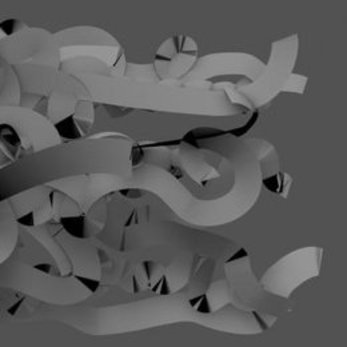
Marcus Schmickler, 'Palace of Marvels [queered pitch]' (editionsMego)
German composer and electronic musician Marcus Schmickler returns to the Graham Foundation on March 15, 2014, for a performance that will explore the correlation between music, language, thought, and representation. Schmickler will present “Semiotic Chora,” a new work that uses sonifications of logical functions and electro-acoustic artifacts.
Marcus Schmickler (b. 1968, Cologne, Germany) studied composition and electronic music and works in both composed and improvised forms. He has won numerous prizes and honors and is closely associated with the Cologne label a-Musik. As a composer, he has worked with the ensemble recherche, the Staatskapelle Weimar, the musikFabrik, the Paragon Ensemble, the Ensemble Zeitkratzer, among others. As a musician, he has performed with artists such as John Tilbury, Thomas Lehn, MIMEO and Julee Cruise. Schmickler lives and works in Cologne.
This performance is presented in partnership with Lampo and with the support from the Goethe-Institut Chicago. Founded in 1997, Lampo is a non-profit organization for experimental music, sound art, and intermedia projects. Visit lampo.org.
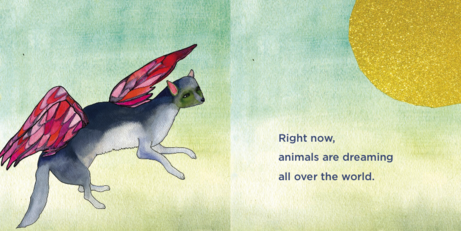
To celebrate the launch of the new Artists’ Board Book series, published by Graham grantee Soberscove Press, the Graham Foundation Bookshop will be hosting a special event for children inside Judy Ledgerwood’s immersive installation, Chromatic Patterns for the Graham Foundation. This innovative series consists of 5 individually-authored books that playfully combine the conventions of the artist’s book with those of children’s board books. On March 15, 2014, children of all ages are invited to create their own board books, finding inspiration in the pattern, color, and ornament of Ledgerwood’s vibrant wall painting and the Foundation’s historic Prairie-style Madlener House. Co-sponsored by Poetry magazine, the launch event will also include an artist-led activity by Jessie Mott, author of Animals Dreaming.
Soberscove's Artists' Board Books are sold individually, as well as in a Limited Edition Boxed Set. Titles include:
Animals Dreaming by Jessie Mott
Dunes at Noons by Brad Tucker
Food Face by Carrie Solomon
Mountain Ocean Sun by David Brainard
A Sunny Day for Flowers by Zehra Khan and Tim Winn
Soberscove Press seeks to make available art-related materials that fill a gap in the literature, are difficult to access, or are created in collaboration with artists. Our publications are intended for a general readership that thrives on intellectual curiosity and visual pleasure.
Jessie Mott is a Chicago-based visual artist and writer whose work employs a menagerie of human, animal, and celestial forms. Mott’s work has been included in many solo and group exhibitions. Her collaborative animations with the artist and writer Steve Reinke have been screened nationally and internationally, and will be presented in the upcoming 2014 Whitney Biennial. Mott received a MFA from Northwestern University and a BFA from New York University.
Founded in Chicago by Harriet Monroe in 1912, POETRY is the oldest monthly devoted to verse in the English-speaking world. Harriet Monroe’s “Open Door” policy, set forth in volume 1 of the magazine, remains the most succinct statement of POETRY’s mission: to print the best poetry written today, in whatever style, genre, or approach. The magazine established its reputation early by publishing the first important poems of T.S. Eliot, Ezra Pound, Marianne Moore, Wallace Stevens, H.D., William Carlos Williams, Carl Sandburg, and other now-classic authors. In succeeding decades it has presented—often for the first time—works by virtually every significant poet of the twentieth century.
Image: from Animals Dreaming by Jessie Mott
Unless otherwise noted,
all events take place at:
Madlener House4 West Burton Place, Chicago
GALLERY AND BOOKSHOP HOURS
2025 Chicago Architecture Biennial
SHIFT: Architecture in Times of Radical Change
Sep 19, 2025–Feb 28, 2026
Wed–Sat, 12–5 p.m.
CONTACT
312.787.4071
info@grahamfoundation.org
Accessibility
Events are held in the ballroom on the third floor which is only accessible by stairs.The first floor of the Madlener House is accessible via an outdoor lift. Please call 312.787.4071 to make arrangements.
Copyright © 2008–2025 Graham Foundation. All rights reserved.
 PREVIOUS POSTS
PREVIOUS POSTS